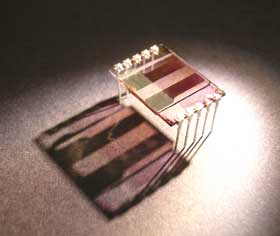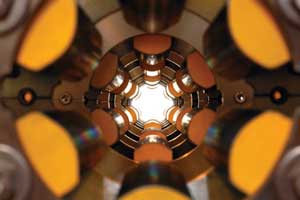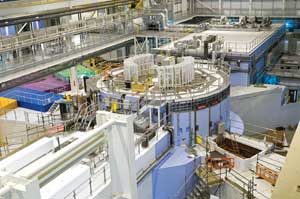
Self-assembling polymers could enable ultracheap solar panels
Dual probes reveal effect of molecular organization on solar efficiency.
It is no surprise that many solar developers believe that polymer (plastic) cells that
can cover huge areas could help bring us into a new age of renewable energy. Polymer
solar cells are much cheaper to produce than conventional silicon types and have
the potential to be produced in large quantities. But first, their efficiencies,
which lag behind those of silicon solar cells, must be improved.
Scientists from the Universities of Sheffield and Cambridge in
the UK have found that, when complex mixtures of molecules in solution are spread
onto a surface, the various molecules separate to the top and bottom of the layer
in a way that maximizes the efficiency of the resulting solar cell.

Solar cell with polymer structure. Courtesy of Dr. Andrew Parnell.
“Our results give important insights into how ultracheap
solar energy panels for domestic and industrial use can be manufactured on a large
scale,” said Dr. Andrew Parnell of the University of Sheffield. “Rather
than using complex and expensive fabrication methods to create a specific semiconductor
nanostructure, high-volume printing could be used to produce nano-scale (60-nm)
films of solar cells that are more than a thousand times thinner than the width
of a human hair.
“These films could then be used to make cost-effective,
light and easily transportable plastic solar cell devices such as solar panels.”
The researchers discovered that the useful self-assembly nature
of the molecules had taken place by probing the morphology and composition of the
solar cells using the Diamond Light and ISIS neutron sources at the Science and
Technology Facilities Council at Rutherford Appleton Laboratory in Oxfordshire.

The Diamond Light Source. Courtesy of the Science and Technology Facilities Council.
In the work, which was published in the July 4 issue of Advanced
Energy Materials, two molecules – PCDTBT and PCBM – were blended together.
The mixture was then deposited as a thin film onto a silicon substrate using spin-coating
techniques. The silicon substrate provides an ultraflat surface from which the polymer
solar cell layer can be characterized in an unambiguous way.
To reveal the inner distribution of molecules, the team shone
bright beams from the Diamond x-ray source onto the solar cell’s surface to
study the crystallinity of the material, while neutrons from the ISIS neutron source
were used to examine the material’s composition profile.

The ISIS target station. Courtesy of the Science and Technology Facilities Council.
“The advantage of these two techniques is that they allow
us to probe the polymer solar cell layer in a nondestructive way and allow us to
peer below the surface and study the internal structure of the layer, which we already
know has a big impact on the operation of a polymer solar cell,” Parnell said.
Currently, the polymer solar cell exhibits an efficiency of 4.9
percent; however, Parnell and his colleagues are hoping to boost this to 10 percent
or more for commercial viability.
The research was funded with a grant from the Engineering and
Physical Sciences Research Council, and the collaboration has just been allocated
a new grant to carry out further studies. This includes more analysis into the structure
and function of polymer solar cell materials as well as an examination of new materials
and innovative processes for high-volume manufacture and future commercialization.
Published: September 2011